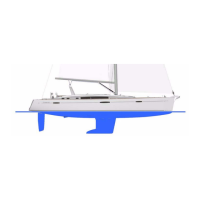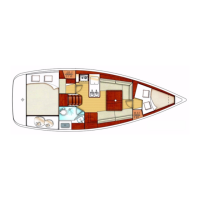Do you have a question about the BENETEAU OCEANIS 46.1 and is the answer not in the manual?
Details on the boat's construction materials and methods.
Specifications for length, beam, draft, and air draft.
Information on engine power and recommended size.
Details on DC and AC electrical systems.
Tank capacities for fuel, water, and waste.
Details on sail areas and dimensions.
Design category, load limits, and displacement for shallow draught.
Design category, load limits, and displacement for deep draught.
Design category, load limits, and displacement for very deep draught.
Explains CE design categories A, B, C, and D for wind and waves.
Factors affecting stability and precautions in heavy weather.
Guidelines for safe access to the cockpit and engine compartment.
Factors affecting helmsman's view and importance of lookout.
Diagram illustrating rigging components and their references.
Details on forestay, stays, and backstay specifications.
Information on halyards, sheets, and control lines.
General points on sail maintenance, storage, and UV protection.
Instructions for setting mainsail systems.
General points and maintenance for deck hardware.
Details on manual and electric winches, including safety.
Operation and maintenance of the genoa furler system.
Description and maintenance of the single line furler.
Measures to prevent man overboard and means of reboarding.
Guidelines for proper storage of the liferaft.
Ensures safety by securing items onboard.
Identifies key deck features like engine brackets and lifebuoy supports.
Information on hull openings, flooding, and stability.
Procedures for operating the emergency tiller.
Precautions and maintenance related to lightning protection.
Risks associated with engines and fuel systems.
Risks related to the boat's electrical system.
Risks associated with the LPG system.
Details on fire extinguishers and fire blankets.
Identifies emergency exits for fire situations.
Overview of the boat's electrical system components.
Battery use, distribution, and charging.
How to use and navigate the touch screen interface.
Details on shore power, generator, and converter use.
Information on anodes and hull plating protection.
Cylinder capacity, hose inspection, and ventilation.
Guidelines for safe operation of LPG appliances.
Procedures for checking the LPG system for leaks.
Layout diagrams for LPG systems.
Safe use of cooking appliances with integrated LPG cylinders.
General points and maintenance for the fridge and icebox.
Details on the water-cooled refrigeration system.
General points, starting, and maintenance for the microwave.
General points and starting procedures for the dishwasher.
Power supply and starting procedures for the TV.
Details on the DC-powered sound system and speaker selection.
Operation, maintenance, and diagrams of the AC system.
Details on sensors, autopilot, and VHF.
Safe use and maintenance of generators and heating systems.
General advice on rinsing, winterisation, and filter cleaning.
Correct operation of water system valves and their lifespan.
Diagram and components for filling fresh water tanks.
Diagrams of water distribution for different cabin layouts.
Details on the water unit and cockpit shower.
General points, diagrams, and use of the blackwater system.
General points on waste water and local regulations.
Precautions regarding coolant, fuel, and ventilation.
Safety warnings about moving engine parts and entanglement.
Engine installation, fuel, and maintenance guidelines.
Essential steps and checks before starting the engine.
Role, inspection, and cleaning of the seawater intake valve.
Function, cleaning, and maintenance of the anti-siphon valve.
Importance of fuel filters and their maintenance.
Diagram showing engine components and their references.
Operation of the engine control lever and instrument panel.
How to access the engine compartment.
Propeller efficiency, cleaning, and speed limits.
Inspection, cable tension, and lubrication guidelines.
Diagrams of the steering system components.
Operation, maintenance, and safety for thruster systems.
Cleaning procedures for GRP, Plexiglas, and stainless steel.
Care for exterior wood, upholstery, and stain removal.
Operation and safety for the electric rear platform.
Procedures for launching and retrieving a tender using davits.
Anchor points, breaking strengths, and towing safety.
Main elements of the chain locker system.
Use, maintenance, and emergency procedures for the electric windlass.
Cleaning and stain removal for leather and synthetic fabrics.
Care for varnished panels and floors.
General interior cleaning and airing advice.
Guidelines for lifting slings and hull preparation.
Hull preparation and antifouling application guidelines.
Keel inspection, maintenance, and incident response.
Safety precautions for launching and lifting the boat.
Requires professional rigger consultation.
Comprehensive steps for winterizing the boat.
Packing plans and dimensions for boat transport.
Recycling, disposal, and pollution prevention guidelines.
Explanation of labels, symbols, and colour codes used in diagrams.
| Hull Length | 13.65 m |
|---|---|
| Fuel Capacity | 200 L |
| Engine Power | 57 HP |
| Length Overall | 14.6 m |
| Beam | 4.5 m |
| Draft | 2.35 m |
| Water Capacity | 370 L |
| Cabins | 3 |
| CE Certification | C14 |
| Berths | 6 to 8 |











